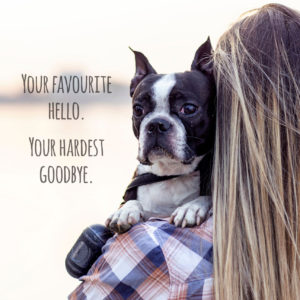by Nancy Blair for Boston Terrier Rescue Canada
My first experience with pet bereavement was when I went to a counsellor after my first dog Lockie died of lung cancer. The counsellor helped me through that terrible time. My next dog was Tyson, a retired greyhound, and a natural therapy dog. He worked with me in Animal Assisted Therapy for five years. At one point I realized, with horror, that when he died, I would have to deal with my own grief and also the grief of my clients and the staff I worked with. It was then that decided that I needed to become a Pet Loss and Bereavement Counsellor.
I, like many others, looked for where I could get training. As a Canadian Certified Counsellor (CCC) with the Canadian Counselling and Psychotherapy Association (CCPA) and a Registered Counselling Therapist (RCT) with the Nova Scotia College of Counselling Therapists (NSCCT) I wanted training that would complement my training to date. I connected with the Association of Pet Loss and Bereavement (APLB) and was greatly impressed by the rigour of their training, their compassion and ability of their volunteers, and their passion for helping people suffering the death or loss of a beloved pet. I took the training and for a year became an Assistant Host on the Tuesday chat. The individuals with APLB training come a wide range various of backgrounds – each brings their own gifts and talents.
 Over the five years that I have worked in Pet Loss and Bereavement I have met many incredible individuals and couples. I have found that the more someone understands this type of grief, the better. I want to make sure that individuals have the tools they need to work through their grief. Sometimes an individual comes to me shocked and frightened by how terrible they feel. Many can move forward in their grieving and healing once they hear that there is nothing wrong with them and that it is ‘ok’ to feel terrible – for a while. Of course, other individuals need more support.
Over the five years that I have worked in Pet Loss and Bereavement I have met many incredible individuals and couples. I have found that the more someone understands this type of grief, the better. I want to make sure that individuals have the tools they need to work through their grief. Sometimes an individual comes to me shocked and frightened by how terrible they feel. Many can move forward in their grieving and healing once they hear that there is nothing wrong with them and that it is ‘ok’ to feel terrible – for a while. Of course, other individuals need more support.
I always suggest the APLB chat rooms. I also suggest the book “The Loss of a Pet: A Guide to Coping with The Grieving Process When a Pet Dies, 4th Edition” written by Wallace Side, Ph.D. the founder of the APLB.
Everyone grieves differently; however, there are commonalities. For example, grief is both emotional and physical. It is very important to take care of ourselves as – well as we can – when a beloved pet dies. I often hear individuals say that they are shocked how much they cry. Sometimes they say that they cry more over the death of a pet than the death of a beloved member of their human family. This is not unusual; it does not mean that they do not love their human family member. On a very practical level, I remind them that they need to drink water, to take in fluids; crying is very dehydrating.
I always check to see if someone is feeling guilt – for whatever reason. Sometimes an individual who was a caregiver for their pet suffers from the loss of that role. This loss is sometimes complicated by feelings of guilt – despite having dedicated themselves to their beloved pet. Also, I always talk with the individual about the death itself, whether it was natural or by euthanasia. Making the decision to euthanize a beloved pet and seeing it through can be shattering.
Something that most individuals have to deal with is finding others who understand this kind of grief. Grieve over a pet is what we call disenfranchised grief. This means that there is not the societally accepted ways of expressing grief and giving comfort that we have after the death of a human. However, grief over a pet is becoming much more accepted. For example, you can find sympathy cards, and funerals for pets are becoming more common. I encourage people to talk to family and friends who are ‘animal people’ – humans who understand the intensity of this type of grief and who are sympathetic.
As grief eases, most deal with the pain of feeling guilty that they are feeling good again. This does not need to last. I work with individuals to help them move through their grief so that they come to a point where they remember their pet with happiness, not guilt or terrible grief. That does not mean they, or we, ever forget their, or our, pets. And there will be times, over the years, that they/we will remember and cry. However, I want us all to remember our pets with all the joy with which they lived their lives – all the joy they gave us and all the joy we gave them.

